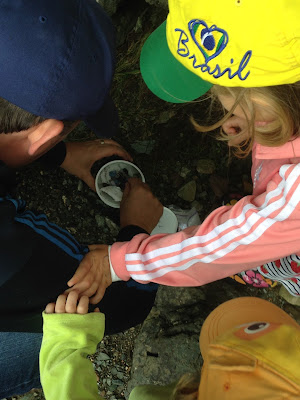GEOCHACHING
East Coast trip - 2015
It all started by accident. While visiting a lighthouse in New Brunswick, a woman was bending to see something under a deck stairs.
"Do you need help," a promptly asked, thinking he had lost something. "I am just geocaching," she said, still looking for something on the ground.
As, few seconds later, she was explaining to us what geocaching is, I was hooked already.
But what is geocaching? It's like a modern day treasure hunt. Basically you download an app that uses your phone's GPS to indicate places - close to where you are - where something was hidden by someone.
The treasures are hidden all over the world and have different degrees of difficulty. The thrill is not about what you will find, but how you will get to it. On trees, under rocks in the middle of the woods, inside building cracks, the boxes can be anywhere.
The rule says that "you take something and you leave something", meaning you need to be prepared and have a small toy to leave once you find a box, as well.
This game is perfect for kids and my girls just loved geocaching all over PEI and New Brunswick. Here are some of the great finds:
Date: August 30th
Place: Cape Enrage, New Brunswick, under the stair to the lighthouse
Difficulty: not too hard because someone told us about it. It was the first time we heard about geocaching
Got: a strawberry shortcake doll
Left: The lady who was with us left something I didn't see. I was too excited about our prize
Date: August 30th
Place: stuck high up to rocks close to the waterfall at Point Wolfe when the tide was low.
Difficulty: none because it was found by accident by Mike. He saw the box and wondered what it was. We opened it and bang!
Got: a sticker
Left: a flower necklace
Date: September 1st
Place: Rainbow Bride - it's on the 915 costal highway
Difficulty: easy. It was right at the beginning of the bridge
Got: a strawberry bracelet
Left: a flower bracelet - used to match the necklace left at the Point Wolfe
Date: September 1st
Place: Old New Brunswick Bank
Difficulty: a bit difficult because it was up hanging on a pine tree, inside the branches. Also, It was not a box, like we were looking for.
Got: nothing. It was just a tiny long container - the size of a normal toothbrush head - with a piece of paper to log in
Left: nothing. No space.
Date: September 2nd
Place: It was inside a stump on an unnamed dirty road at South Rustico, P.E.I.
Difficulty: it was not that easy since we had to look in a forest, filled with mosquitos
Got: a little plastic spider
Left: a pack with 14 temporary tattoos
Date: September 3
Place: in the woods of Victoria Park, Charlottetown, P.E.I.
Difficulty: not too hard to find. Actually Juju found it.
Got: an easter eggs stickers
Left: a plastic colourful bracelet
Date: September 4
Place: the Anglican Church of St. Mark's in South Rustico, P.E.I.
Difficulty: a bit hard to find, because according to the tip it was suppose to be hanging, but I guess it fell off the tree.
I can't remember what we got and left.
Date: September 4
Place: On the side of a small road, along the golf course in Cymbria, P.E.I.
Difficulty: not hard at all. it was hanging on a pine tree on the side of the road. Also, it was easy to find a bigger container (medium size).
Got: this was a good one with lots of stuff, so we picked two things and left two. We got a scary Peez and a little kinder egg dinosaur
Left: a little bottle with liquid to make bubbles and temporary tattoos. Also, I didn't take it, but I had to take a photo of this fun token from Texas: Free at last, if says in one side - Retired and on the road - caching since 2007.
MORE ABOUT GEOCACHING
https://www.geocaching.com/play
From Wikipedia: Geocaching is an outdoor recreational activity, in which participants use a Global Positioning System (GPS) receiver or mobile device and other navigational techniques to hide and seek containers, called "geocaches" or "caches", at specific locations marked by coordinates all over the world.
MORE ABOUT GEOCACHING
https://www.geocaching.com/play
From Wikipedia: Geocaching is an outdoor recreational activity, in which participants use a Global Positioning System (GPS) receiver or mobile device and other navigational techniques to hide and seek containers, called "geocaches" or "caches", at specific locations marked by coordinates all over the world.
A typical cache is a small waterproof container containing a logbook and sometimes a pen or pencil. The geocacher enters the date they found it and signs it with their established code name, in order to prove that they found it. After signing the log, the cache must be placed back exactly where the person found it. Larger containers such as plastic storage containers (Tupperware or similar) or ammunition boxes can also contain items for trading, such as toys or trinkets, usually of more sentimental worth than financial. Geocaching shares many aspects with benchmarking, trigpointing, orienteering, treasure-hunting, letterboxing, and waymarking.












No comments:
Post a Comment